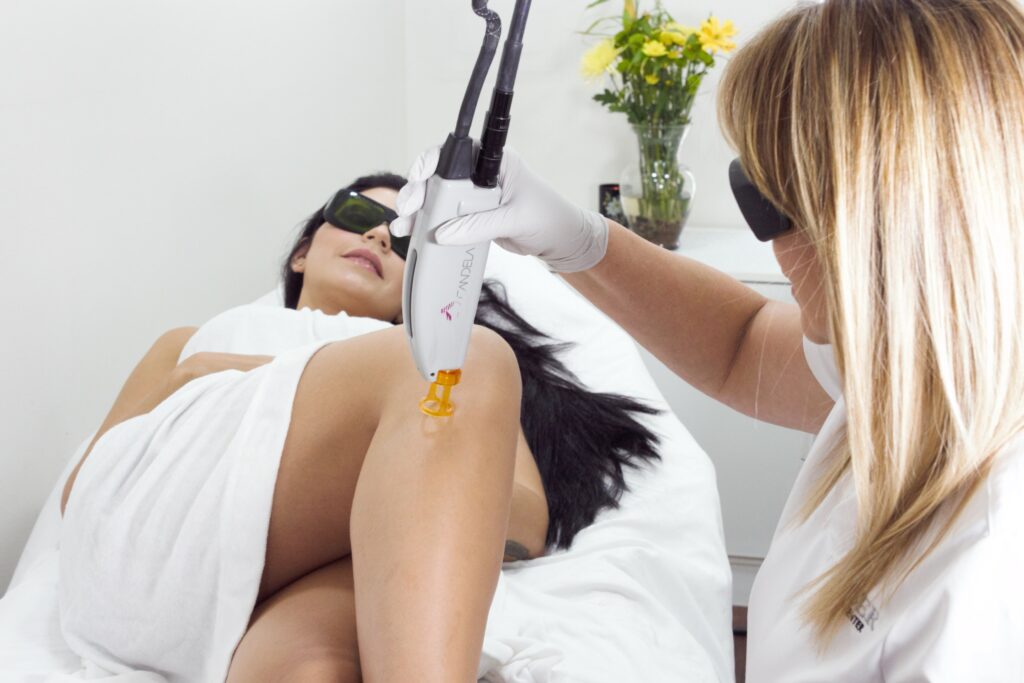Laser treatments have revolutionized dermatology and aesthetics in recent decades. Used for a wide range of procedures, from hair removal to facial rejuvenation, lasers offer a precise and effective alternative to more traditional methods. However, like any technology, these treatments have both advantages and disadvantages that are important to understand before making a decision. In this article, we will explore in detail the benefits and potential limitations of laser treatments so you can make an informed choice about whether they are right for you.
What Are Laser Treatments?
Laser treatments use amplified light to direct energy at specific areas of the body. Lasers can vary in wavelength, which determines their effectiveness in treating different conditions. The most common types of laser treatments include:
- Carbon dioxide (CO2) laser: Used for scar removal, wrinkles, and skin lesions.
- Alexandrite laser: Commonly used for hair removal.
- Erbium laser: Used for skin rejuvenation and treating superficial wrinkles.
- Fractional laser: Used to treat scars, sunspots, and fine lines.
Each type of laser is designed to penetrate the skin at a specific depth, allowing precise treatment of various conditions.
Advantages of Laser Treatments
1. Precision and Effectiveness
One of the greatest benefits of laser treatments is their precision. Lasers can target very specific areas of the skin without damaging surrounding tissue. This is especially useful in procedures like tattoo removal or reducing sunspots, where precise intervention is required.
Scientific background: A study published in the Journal of the American Academy of Dermatology shows that lasers, especially those with specific wavelengths, can effectively treat pigmented skin lesions without affecting the surrounding skin.
2. Reduced Recovery Time
Unlike more invasive treatments such as surgery, laser procedures often require less recovery time. Patients can return to their normal activities much faster, making these treatments convenient for those with busy lifestyles.
Scientific background: According to an article in Dermatologic Surgery, patients undergoing laser treatments tend to experience less downtime compared to more invasive surgical procedures, thanks to the non-invasive nature of the laser.
3. Long-Lasting Results
In many cases, laser treatments provide longer-lasting results than traditional methods. For example, laser hair removal can permanently reduce hair growth compared to shaving or waxing, which only offer temporary results.
Scientific background: A study in the Journal of Cosmetic Dermatology concludes that laser hair removal can reduce hair growth by 70-90% after a complete cycle of treatments.
4. Versatility
Laser treatments are incredibly versatile and can be used for a variety of skin conditions. From removing sunspots and acne scars to reducing wrinkles and fine lines, lasers can address multiple issues in a single session.
Scientific background: Research published in the Journal of Clinical and Aesthetic Dermatology notes that fractional lasers can significantly improve skin tone and texture, making these treatments a popular option for skin rejuvenation.
Disadvantages of Laser Treatments
1. Multiple Sessions Required
To achieve the desired results, most laser treatments require multiple sessions. For example, laser hair removal generally requires between 4 and 8 sessions to be effective. This not only increases the cost but also the time the patient must dedicate to the treatment.
Scientific background: According to the Journal of Cosmetic and Laser Therapy, the effectiveness of laser treatments increases with the number of sessions, but this can also be a drawback for patients seeking quick results.
2. Limitations Based on Skin Type
Not all skin types respond equally to laser treatments. People with darker skin tones are at higher risk of hyperpigmentation or scarring, as lasers can affect the melanin in the skin. This limits treatment options for some people and requires a more careful approach.
Scientific background: An article in the Journal of Investigative Dermatology highlights that advances in laser technology have improved their safety for a variety of skin types, but risks still exist and should be considered.
Final Considerations
When considering a laser treatment, it is essential to weigh the advantages and disadvantages based on your specific needs and skin type. While laser treatments offer many benefits, such as precision, quick recovery, and long-lasting results, they also have limitations, such as high costs, the risk of side effects, and the need for multiple sessions.
It is crucial to consult with a dermatologist or qualified professional who can evaluate your skin type and discuss expectations and possible risks before proceeding. Additionally, following post-treatment care instructions is key to maximizing the benefits of the treatment and minimizing risks.
Conclusion
Laser treatments have transformed the way we approach skin conditions and aesthetics. They offer an effective and versatile option for those seeking to enhance their appearance with long-lasting results. However, they are not a magic solution and come with their own set of challenges. By understanding both the advantages and disadvantages, you can make an informed decision that will help you achieve your skincare goals safely and effectively. At Idealaser, you’ll have experts who will give you the best recommendation.
